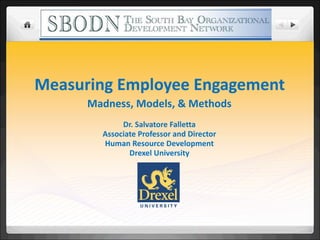
Organizational Intelligence Surveys: Models, Methods & Madness by Dr. Salvatore Falletta
- 1. Measuring Employee Engagement Madness, Models, & Methods Dr. Salvatore Falletta Associate Professor and Director Human Resource Development Drexel University
- 3. THE EVOLVING NATURE OF EMPLOYEE SURVEYS
- 9. I. Grounded in Science Good Practice Good Practice Good Practice Good Practice
- 10. Avoid Fads, Trends, and Pre-Conceived Notions
- 13. Nadler and Tushman define congruence as the degree to which needs, demands, goals, objectives, and/or structures of one construct of the model (e.g., the system inputs) are consistent or fit with the needs, demands, goals, objectives, and/or structures of another construct of the model (e.g., outputs). In diagnosing an organization through the use of this model, paired comparisons of constructs in the model are performed. Nadler & Tushman’s Congruence Model (1980)
- 14. Although fundamentally similar to the Nadler and Tushman notion of congruence, in Tichy’s framework there are only three primary variables to consider: (1) the technical (e.g., production methods, resources, organizational design, management systems), (2) the political (e.g., power, decision-making, senior leadership, union relations), and the (3) cultural (e.g., normative glue, values, beliefs, history, communication) dynamics of the organization. The prescribed networks (i.e., the formal organization) have to do with the designed social structure of the organization, such as the organization of departments and the communication and authority networks. Emergent networks , refers to the structures and processes in the organization which emerge informally. Tichy’s Technical, Political, and Cultural Model (1983)
- 15. Burke and Litwin do not place an emphasis on diagnosing system congruence or alignment. Instead, they emphasize the importance of the interrelationships (or drivers) among the variables in the model, and how these predict behavior and affect change. Burke-Litwin Model (1992 )
- 16. The Organizational Intelligence Model™ depicted on the left serves as an useful framework to facilitate the design and interpretation of most employee and organizational survey efforts. This model includes 11 factors or variables that impact employee engagement and organizational performance and defines important factors and relationships to consider during HR strategic planning and organizational change initiatives . Organizational Intelligence Model (Falletta, 2008 )
- 17. Factor Descriptions: Organizational Intelligence Model Environmental Inputs The outside conditions or situations that affect the company/organization (e.g., Sarbanes-Oxley, government policy, competitive intelligence, customer feedback, the economy, corporate social responsibilities). Strategy The means by which the company/organization intends on achieving its overall mission and goals. Leadership The most senior level of executives and managers in the company/organization. Culture The underlying values, beliefs and norms that drive team and organizational behavior. Structure & Adaptability The structure is how the company/organization is designed (i.e., levels, roles, decision rights, responsibilities and accountabilities) to execute on the strategy. Whereas, adaptability refers to the extent to which the company/organization is ready and able to change. Information & Technology The business systems, practices, and capabilities that facilitate and reinforce people’s work (e.g., IT infrastructure, communication, knowledge sharing). Direct Manager The relative quality and effectiveness of your immediate manager or supervisor. Measures & Rewards Measures refer to the ways in which individual and team performance and accomplishments are measured and managed. Rewards are the monetary and non-monetary incentives that reinforce people's behavior and actions, including advancement and promotion. Growth & Development The practices, resources, and opportunities available for employee skill development and enhancement, including development planning, training and learning, and stretch assignments. Employee Engagement E mployee engagement involves the cognitive, emotional and behavioral relationship employees have with their jobs and organizations, and effort and enthusiasm they put into their daily work (i.e., the extent to which employees contribute their discretionary energy and effort on behalf of the organizations they serve). Performance Outputs The outcomes and indicators of individual and organizational achievement and results.
- 22. SURVEY REPORTING The percent favorable, neutral, and unfavorable groupings are artificial and largely for the sake of simplicity Ensure that you examine the full range of the distribution Don’t forget the “neutral” score
- 29. MADNESS, MYTHS, & MISCONCEPTIONS
- 30. ABOUT THE SPEAKER Dr. Salvatore Falletta has over 20 years experience in human resources, workplace learning and performance, human capital management and organization development. Sal is Associate Professor and Program Director for Human Resource Development (HRD) at Drexel University. He is also the Founder and Chairperson for Leadersphere, Inc – a HR intelligence consulting firm that specializes in employee and organizational surveys, 360 degree feedback systems, measurement and evaluation processes, general HR strategy, employee engagement, and OD consulting. Prior to Drexel and Leadersphere, Sal was Vice President and Chief HR Officer for a Fortune 1000 company based in the Silicon Valley, California and has held management and consulting positions in human resources at several best-in-class companies, including Nortel Networks, Alltel, Intel Corporation, SAP AG, and Sun Microsystems. While at Intel, Sal managed the global employee survey program, performed leadership development needs assessments and organizational behavior research studies, and participated in corporate HR strategy efforts. He also led the training measurement and evaluation function at Nortel Network’s Technical Education Centers. Sal is an accomplished speaker, researcher, and author. He frequently presents at conferences and seminars and has co-authored the Targeted Evaluation Process (ASTD Press, 2000), and several other book chapters and articles including a recent feature article on “Organizational Intelligence Surveys” for Training & Development (June 2008). He is currently writing a book HR Intelligentsia: An Oasis for Science and Reason (forthcoming). Sal holds a doctoral degree with a specialization in human resource development and organizational behavior from North Carolina State University. He can be reached at [email_address] or 916-213-8773.
